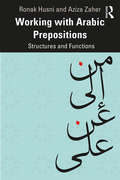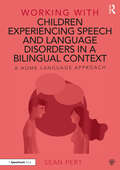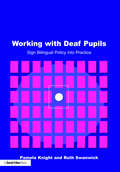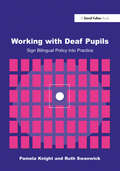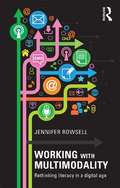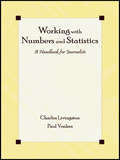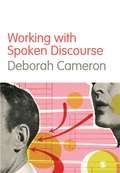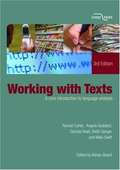- Table View
- List View
Working with Arabic Prepositions: Structures and Functions
by Ronak Husni Aziza ZaherWorking with Arabic Prepositions: Structures and Functions is a reference book focusing on Arabic prepositions, their structure and usage. The system of Arabic prepositions is complex, and the textbook aims to assist students at the lower intermediate to advanced level understand it in an accessible way. This is an area in which students can experience great difficulty, and the aim of this book is to explain clearly the structures and functions of Arabic prepositions and their usage in Modern Standard Arabic and media Arabic. Drills and exercises are provided to enable readers to practice what they have learned in the chapters. This book will be an ideal source of information for undergraduate students studying Arabic, as well as graduate studies and additional courses in the major dialect areas, and a very useful resource for teachers of Arabic as a foreign language.
Working with Children Experiencing Speech and Language Disorders in a Bilingual Context: A Home Language Approach (Working With)
by Sean PertThe complexity of speech and language disorders can be daunting in a monolingual context. When working with a bilingual child assessment and intervention may appear to be even more complicated. In this book Sean Pert provides the reader with the tools needed to overcome this perception and develop skills in working in a language that they don’t share with the client. By adopting a home language first approach the book discusses how to: identify diversity from disorder introduce effective approaches in line with the best clinical practice work successfully alongside interpreters make assessments and plan interventions set goals for therapy. At the heart of the text is the therapist creating essential partnerships with parents and truly valuing the bilingualism, culture and identity of the child. This leads to better outcomes, not only in speech, language and communication, but also in self-esteem, mental health, social participation and educational and employment success. The book concludes with a handy toolkit of resources including quizzes, case studies and printable extras making it the perfect resource for both experienced and newly qualified practitioners with bilingual and multilingual children in their care.
Working with Children Experiencing Speech and Language Disorders in a Bilingual Context: A Home Language Approach (Working With)
by Sean PertThe complexity of speech and language disorders can be daunting in a monolingual context. When working with a bilingual child assessment and intervention may appear to be even more complicated. In this book Sean Pert provides the reader with the tools needed to overcome this perception and develop skills in working in a language that they don’t share with the client. By adopting a home language first approach the book discusses how to: identify diversity from disorder introduce effective approaches in line with the best clinical practice work successfully alongside interpreters make assessments and plan interventions set goals for therapy. At the heart of the text is the therapist creating essential partnerships with parents and truly valuing the bilingualism, culture and identity of the child. This leads to better outcomes, not only in speech, language and communication, but also in self-esteem, mental health, social participation and educational and employment success. The book concludes with a handy toolkit of resources including quizzes, case studies and printable extras making it the perfect resource for both experienced and newly qualified practitioners with bilingual and multilingual children in their care.
Working with Deaf Children: Sign Bilingual Policy into Practice
by Pamela Knight Ruth SwanwickThis book is essential and accessible reading for all teachers and professionals who are working with sign bilingual deaf children. It considers the background and theory underpinning current developments in sign bilingual education and the implications for policy and developing classroom practice. Practical teaching strategies are suggested and evaluated. The authors draw on their own experience of working in sign bilingual settings as well as current good practice and relevant research. This book is the first UK book that describes sign bilingual education (beyond policy). It is also the first book to support sign bilingual practice dealing with current educational issues. The authors draw together relevant research and practice in sign bilingual education and present practical strategies for teachers.
Working with Deaf Children: Sign Bilingual Policy into Practice
by Pamela Knight Ruth SwanwickThis book is essential and accessible reading for all teachers and professionals who are working with sign bilingual deaf children. It considers the background and theory underpinning current developments in sign bilingual education and the implications for policy and developing classroom practice. Practical teaching strategies are suggested and evaluated. The authors draw on their own experience of working in sign bilingual settings as well as current good practice and relevant research. This book is the first UK book that describes sign bilingual education (beyond policy). It is also the first book to support sign bilingual practice dealing with current educational issues. The authors draw together relevant research and practice in sign bilingual education and present practical strategies for teachers.
Working with Faculty Writers
by Anne Ellen Geller Michele EodiceThe imperative to write and to publish is a relatively new development in the history of academia, yet it is now a significant factor in the culture of higher education. Working with Faculty Writers takes a broad view of faculty writing support, advocating its value for tenure-track professors, adjuncts, senior scholars, and graduate students. The authors in this volume imagine productive campus writing support for faculty and future faculty that allows for new insights about their own disciplinary writing and writing processes, as well as the development of fresh ideas about student writing. Contributors from a variety of institution types and perspectives consider who faculty writers are and who they may be in the future, reveal the range of locations and models of support for faculty writers, explore the ways these might be delivered and assessed, and consider the theoretical, philosophical, political, and pedagogical approaches to faculty writing support, as well as its relationship to student writing support. With the pressure on faculty to be productive researchers and writers greater than ever, this is a must-read volume for administrators, faculty, and others involved in developing and assessing models of faculty writing support.
Working with German Corpora: with a foreword by John Sinclair
by Bill DoddThe essays in this volume, writen by Germanists from Britain, Ireland, the USA and Australia, illustrate the enormous potential which corpus-based work has for German Studies as a whole and the rich diversity of work currently being undertaken. A detailed introduction explains basic concepts, methods, and applications of corpus-based work.
Working with Multimodality: Rethinking Literacy in a Digital Age
by Jennifer RowsellIn today’s digital world, we have multiple modes of meaning-making: sounds, images, hypertexts. Yet, within literacy education, even ‘new’ literacies, we know relatively little about how to work with and produce modally complex texts. In Working with Multimodality, Jennifer Rowsell focuses on eight modes: words, images, sounds, movement, animation, hypertext, design and modal learning. Throughout the book each mode is illustrated by cases studies based on the author’s interviews with thirty people, who have extensive experience working with a mode in their field. From a song writer to a well known ballet dancer, these people all discuss what it means to do multimodality well. This accessible textbook brings the multiple modes together into an integrated theory of multimodality. Step-by-step, beginning with theory then exploring modes and how to work with them, before concluding with how to apply this in an investigation, each stage of working with multimodality is covered. Working with Multimodality will help students and scholars to: • Think about specific modes and how they function • Consider the implications for multimodal meaning-making • Become familiar with conventions and folk knowledge about given modes • Apply this same knowledge to their own production of media texts in classrooms Assuming no prior knowledge about multimodality and its properties, Working with Multimodality is designed to appeal to advanced undergraduate and postgraduate students interested in how learning and innovation is different in a digital and media age and is an essential textbook for courses in literacy, new media and multimodality within applied linguistics , education and communication studies.
Working with Multimodality: Rethinking Literacy in a Digital Age
by Jennifer RowsellIn today’s digital world, we have multiple modes of meaning-making: sounds, images, hypertexts. Yet, within literacy education, even ‘new’ literacies, we know relatively little about how to work with and produce modally complex texts. In Working with Multimodality, Jennifer Rowsell focuses on eight modes: words, images, sounds, movement, animation, hypertext, design and modal learning. Throughout the book each mode is illustrated by cases studies based on the author’s interviews with thirty people, who have extensive experience working with a mode in their field. From a song writer to a well known ballet dancer, these people all discuss what it means to do multimodality well. This accessible textbook brings the multiple modes together into an integrated theory of multimodality. Step-by-step, beginning with theory then exploring modes and how to work with them, before concluding with how to apply this in an investigation, each stage of working with multimodality is covered. Working with Multimodality will help students and scholars to: • Think about specific modes and how they function • Consider the implications for multimodal meaning-making • Become familiar with conventions and folk knowledge about given modes • Apply this same knowledge to their own production of media texts in classrooms Assuming no prior knowledge about multimodality and its properties, Working with Multimodality is designed to appeal to advanced undergraduate and postgraduate students interested in how learning and innovation is different in a digital and media age and is an essential textbook for courses in literacy, new media and multimodality within applied linguistics , education and communication studies.
Working With Numbers and Statistics: A Handbook for Journalists
by Charles Livingston Paul S. VoakesWorking With Numbers and Statistics: A Handbook for Journalists will bolster math skills and improve math confidence for journalists at all skill levels. Authors Charles Livingston and Paul Voakes developed this resource book to improve journalistic writing and reporting, enabling journalists to:*make accurate, reliable computations, which in turn enables one to make relevant comparisons, put facts into perspective, and lend important context to stories;*recognize inaccurate presentations, whether willfully spun or just carelessly relayed;*ask appropriate questions about numerical matters;*translate complicated numbers for viewers and readers in ways they can readily understand;*understand computer-assisted reporting; and*write livelier, more precise pieces through the use of numbers.The math is presented in a journalistic context throughout, enabling readers to see how the procedures will come into play in their work.Working With Numbers and Statistics is designed as a reference work for journalism students developing their writing and reporting skills. It will also serve professionals as a useful tool to improve their understanding and use of numbers in news stories.
Working With Numbers and Statistics: A Handbook for Journalists
by Charles Livingston Paul S. VoakesWorking With Numbers and Statistics: A Handbook for Journalists will bolster math skills and improve math confidence for journalists at all skill levels. Authors Charles Livingston and Paul Voakes developed this resource book to improve journalistic writing and reporting, enabling journalists to:*make accurate, reliable computations, which in turn enables one to make relevant comparisons, put facts into perspective, and lend important context to stories;*recognize inaccurate presentations, whether willfully spun or just carelessly relayed;*ask appropriate questions about numerical matters;*translate complicated numbers for viewers and readers in ways they can readily understand;*understand computer-assisted reporting; and*write livelier, more precise pieces through the use of numbers.The math is presented in a journalistic context throughout, enabling readers to see how the procedures will come into play in their work.Working With Numbers and Statistics is designed as a reference work for journalism students developing their writing and reporting skills. It will also serve professionals as a useful tool to improve their understanding and use of numbers in news stories.
Working with Portuguese Corpora
by Susan Francia Anne StobartAlthough Portuguese is one of the main world languages and researchers have been working on Portuguese electronic text collections for decades (e.g. Kelly, 1970; Biderman, 1978; Bacelar do Nascimento et al., 1984; see Berber Sardinha, 2005), this is the first volume in English that encapsulates the exciting and cutting-edge corpus linguistic work being done with Portuguese language corpora on different continents. The book includes chapters by leading corpus linguists dealing with Portuguese corpora across the world, and their contributions explore various methods and how they are applicable to a wide range of language issues. The book is divided into six sections, each covering a key issue in Corpus Linguistics: lexis and grammar, lexicography, language teaching and terminology, translation, corpus building and sharing, and parsing and annotation. Together these sections present the reader with a broad picture of the field.
Working with Portuguese Corpora
by Tony Berber Sardinha Telma De FerreiraAlthough Portuguese is one of the main world languages and researchers have been working on Portuguese electronic text collections for decades (e.g. Kelly, 1970; Biderman, 1978; Bacelar do Nascimento et al., 1984; see Berber Sardinha, 2005), this is the first volume in English that encapsulates the exciting and cutting-edge corpus linguistic work being done with Portuguese language corpora on different continents. The book includes chapters by leading corpus linguists dealing with Portuguese corpora across the world, and their contributions explore various methods and how they are applicable to a wide range of language issues. The book is divided into six sections, each covering a key issue in Corpus Linguistics: lexis and grammar, lexicography, language teaching and terminology, translation, corpus building and sharing, and parsing and annotation. Together these sections present the reader with a broad picture of the field.
Working with Spanish Corpora (Corpus and Discourse)
by Edited by Giovanni ParodiThe main focus of this book is the investigation of linguistic variation in Spanish, considering spoken and written, specialised and non-specialised registers from a corpus linguistics approach and employing computational updated tools. The ten chapters represent a range of research on Spanish using a number of different corpora drawn from, amongst others, research articles, student writing, formal conversation and technical reports. A variety of methodologies are brought to bear upon these corpora including multi-dimensional and multi-register analysis, latent semantics and lexical bundles. This in-depth analysis of using Spanish corpora will be of interest to researchers in corpus linguistics or Spanish language.
Working with Spanish Corpora (Corpus and Discourse)
by Giovanni ParodiThe main focus of this book is the investigation of linguistic variation in Spanish, considering spoken and written, specialised and non-specialised registers from a corpus linguistics approach and employing computational updated tools. The ten chapters represent a range of research on Spanish using a number of different corpora drawn from, amongst others, research articles, student writing, formal conversation and technical reports. A variety of methodologies are brought to bear upon these corpora including multi-dimensional and multi-register analysis, latent semantics and lexical bundles. This in-depth analysis of using Spanish corpora will be of interest to researchers in corpus linguistics or Spanish language.
Working with Specialized Language: A Practical Guide to Using Corpora
by Lynne Bowker Jennifer PearsonWorking with Specialized Language: a practical guide to using corpora introduces the principles of using corpora when studying specialized language. The resources and techniques used to investigate general language cannot be easily adopted for specialized investigations. This book is designed for users of language for special purposes (LSP). Providing guidelines and practical advice, it enables LSP users to design, build and exploit corpus resources that meet their specialized language needs. Highly practical and accessible, the book includes exercises, a glossary and an appendix describing relevant resources and corpus-analysis software. Working with Specialized Language is ideal for translators, technical writers and subject specialists who are interested in exploring the potential of a corpus-based approach to teaching and learning LSP.
Working with Specialized Language: A Practical Guide to Using Corpora
by Lynne Bowker Jennifer PearsonWorking with Specialized Language: a practical guide to using corpora introduces the principles of using corpora when studying specialized language. The resources and techniques used to investigate general language cannot be easily adopted for specialized investigations. This book is designed for users of language for special purposes (LSP). Providing guidelines and practical advice, it enables LSP users to design, build and exploit corpus resources that meet their specialized language needs. Highly practical and accessible, the book includes exercises, a glossary and an appendix describing relevant resources and corpus-analysis software. Working with Specialized Language is ideal for translators, technical writers and subject specialists who are interested in exploring the potential of a corpus-based approach to teaching and learning LSP.
Working with Spoken Discourse
by Deborah Cameron"An exemplary textbook. Making even the most complex ideas fully accessible, it is grounded in an extensive literature, filled with engaging examples, and offers ample suggestions for independent research. It’s been a key text in my classes for over a decade and, as fresh and relevant as ever, will continue to buttress my graduate seminars and undergraduate courses alike.” - Professor Crispin Thurlow, University of Washington Comprehensive, practical, lively and accessible, Working with Spoken Discourse is the much-loved benchmark for learning to do discourse analysis. It combines theory and practice to give students the grounding they need in practical techniques of analyzing talk and how to apply them to real data. Begins with the ‘why’ and ‘how’ of doing discourse analysis Packs examples into every chapter to help explain complex concepts Uses exercises and activities to reinforce what you’ve learned Leads you through the practicalities of designing your own project Exceptionally clear, and perfect for undergraduates starting a project, this is the essential guide to spoken discourse.
Working with Spoken Discourse (1st edition)
by Deborah Cameron"An exemplary textbook. Making even the most complex ideas fully accessible, it is grounded in an extensive literature, filled with engaging examples, and offers ample suggestions for independent research. It's been a key text in my classes for over a decade and, as fresh and relevant as ever, will continue to buttress my graduate seminars and undergraduate courses alike. " - Professor Crispin Thurlow, University of Washington Comprehensive, practical, lively and accessible, Working with Spoken Discourse is the much-loved benchmark for learning to do discourse analysis. It combines theory and practice to give students the grounding they need in practical techniques of analyzing talk and how to apply them to real data. Begins with the 'why' and 'how' of doing discourse analysis Packs examples into every chapter to help explain complex concepts Uses exercises and activities to reinforce what you've learned Leads you through the practicalities of designing your own project Exceptionally clear, and perfect for undergraduates starting a project, this is the essential guide to spoken discourse.
Working with Spoken Discourse (PDF)
by Deborah Cameron"An exemplary textbook. Making even the most complex ideas fully accessible, it is grounded in an extensive literature, filled with engaging examples, and offers ample suggestions for independent research. It’s been a key text in my classes for over a decade and, as fresh and relevant as ever, will continue to buttress my graduate seminars and undergraduate courses alike.” - Professor Crispin Thurlow, University of Washington Comprehensive, practical, lively and accessible, Working with Spoken Discourse is the much-loved benchmark for learning to do discourse analysis. It combines theory and practice to give students the grounding they need in practical techniques of analyzing talk and how to apply them to real data. Begins with the ‘why’ and ‘how’ of doing discourse analysis Packs examples into every chapter to help explain complex concepts Uses exercises and activities to reinforce what you’ve learned Leads you through the practicalities of designing your own project Exceptionally clear, and perfect for undergraduates starting a project, this is the essential guide to spoken discourse.
Working with Text and Around Text in Foreign Language Environments (Second Language Learning and Teaching)
by Halina Chodkiewicz Piotr Steinbrich Małgorzata Krzemińska-AdamekThis book investigates the three pivotal points of text for foreign language acquisition: reception, construction and deconstruction. In Part One, the focus is on various aspects of text reception, such as developing literacy, text interest, and perceptions of the academic register or the assessment of spoken language in educational contexts. Part Two deals with various aspects of composing text, such as author identity, lexical constructs or collaborative web-based writing. Lastly, Part Three presents the various segmental items that constitute text, like lexical clustering, L1/L2 relationship, classroom talk as text, etc. The division corresponds with what can be viewed as a logical sequence of text-related processes reflected in formal learning and teaching environments.
Working With Texts: A Core Introduction To Language Analysis (PDF)
by Maggie Bowring Danuta Reah Keith Sanger Adrian Beard Angela Goddard Nikki Swift Ronald CarterWorking with Textsis a well established textbook that introduces students to the main principles of language analysis, through contemporary text examples. Covering a wide range of language areas, the book uses an interactive, activity-based approach to support students' understanding of language structure and variety. The third edition includes: new material on analyzing sound; an updated range of texts, including literary extracts, advertisements, newspaper articles, comic book strips, excerpts from popular comedy sketches, political speeches, telephone discourse, and internet chat; new extension work to support student-directed study; detailed suggestions after each unit for further reading within the Intertextseries as a whole; and an updated list of URLs. ISBN10: 0415414210 (hbk) ISBN10: 0415414245 (pbk) ISBN13: 9780415414210 (hbk) ISBN13: 9780415414241 (pbk)
Working with Written Discourse (PDF)
by Deborah CameronAddressing the practicalities of research, and embracing the complexity and variety of written forms of language, this book: grounds readers in a broad range of concepts, debates and relevant methods focuses on both theoretical questions and the 'how to' of analysis is loaded with practical activities and advice on the design and execution of research highlights computer-mediated communication and new media discourse, from text messages and tweets to mobile phone novels and online encyclopedias draws on data from international and multilingual communities. The perfect companion to Deborah Cameron's best-selling Working with Spoken Discourse , this book equips readers with practical and conceptual tools to ask questions about written discourse, and to analyse the huge variety of texts that make up our linguistic landscape. It is the essential guide for students of discourse analysis in linguistics, media and communication studies, and for social researchers across the social sciences.
The Workings of Language: From Prescriptions to Perspectives
by Rebecca S. WheelerThe essays in this book help to make sense of the workings of language in our everyday world—on the personal, local, national, and international levels. The authors are all linguists, seeking to help readers free themselves of language prejudices, thus opening the way to better informed views on the function of language in society, a more balanced treatment in schools, and more linguistically-sound public policies.Defusing Chicken-Little prognostications about English, this volume suggests that dark claims about language are not to be taken at face value. Instead, these claims function as a signal: time to step back. Offering just such a time-out, eminent linguists explore the fuller picture underlying language in our society, examining prescriptivism, Black English, Ozark English, American Sign Language, English-Only, and Endangered Languages.After helping stomp out such linguistic fires, the linguists showcase the potent workings of language: world englishes, language and politics, media, prejudice, creativity, gender, and humor, thus opening the way to better informed views on the function of language in schools, and more linguistically sound public policies.
Workplace Communication: The Basics, Global Edition
by Mary Anne Poatsy George Searles Robert GrauerWorkplace Communications is the first brief, less theory-intensive text that focuses on the fundamentals of workplace communication specifically intended for applied writing courses in community colleges and similar settings. Written in a conversational style and featuring a clean, uncluttered page layout, Workplace Communications is designed to be accessible. The high quantity of examples, illustrations, and exercises emphasize practical applications to ensure the text is user-friendly. Workplace Communications is an ideal text to bridge business communication and technical communication courses. The full text downloaded to your computer With eBooks you can: search for key concepts, words and phrases make highlights and notes as you study share your notes with friends eBooks are downloaded to your computer and accessible either offline through the Bookshelf (available as a free download), available online and also via the iPad and Android apps. Upon purchase, you'll gain instant access to this eBook. Time limit The eBooks products do not have an expiry date. You will continue to access your digital ebook products whilst you have your Bookshelf installed.
